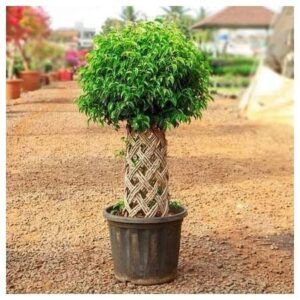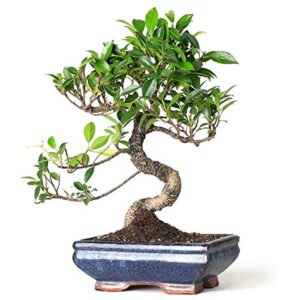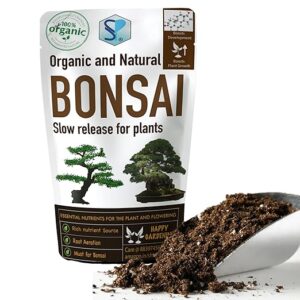Ficus fig bonsai Tree
Growing a bonsai tree is more than only an interest; it’s an innovative shape that infuses your dwelling area with the peace of nature. The Ficus Fig Bonsai Tree is one of the maximum nicely-favored alternatives among bonsai fans. This adaptable and resilient species is good for newbies and pro cultivators alike. We’ll learn the whole lot you require to cultivate your very own Ficus fig bonsai in this manual.

Introduction to Ficus Fig Bonsai Tree
The Ficus Fig Bonsai Tree is an extraordinary choice for bonsai enthusiasts due to its versatility and resilience. A thick trunk, glossy leaves, and complex root machine provide outstanding stability of visible enchantment and low preservation.
You can also check 7 Secrets to Grow Citrus Plants
History and Origin
With more than 800 species, the genus Ficus is native to tropical areas of the sector, together with Asia and the Mediterranean. The practice of developing Ficus for bonsai has its origins in Chinese and Japanese gardening traditions and has been round for masses of years.
Types of Ficus Fig Bonsai Tree
Ficus Retusa
Ficus Retusa is famed for its easy, grey bark and putting aerial roots. This species is in particular desired for its particular, twisted trunk shapes.
Ficus Benjamina
Ficus Benjamina, often referred to as the Weeping Fig, is prominent by using the use of its thin, smooth leaves and brief, arching branches. The preference to increase a flowing, sensitive bonsai is immoderate.
Ficus Microcarpa
Ficus Microcarpa, every so often called the Chinese Banyan, is distinctly valued for its dense foliage and thick, aerial roots that resemble banyans, which make it best for creating dramatic, woodland-style bonsai.
Selecting the Right Ficus Fig Bonsai Tree
When choosing a Ficus Fig Bonsai, recall factors just like the size of your space, the amount of herbal mild available, and your stage of enjoyment. Young vegetation is simpler to train, while older specimens might also have more advanced trunk structures.
Ideal Growing Conditions
Light Requirements
Ficus Fig Bonsai prospers in vivid, indirect mild. Direct sunlight can scorch the leaves, so it’s satisfactory to location your bonsai close to a window with filtered light or use a developed light.
Temperature and Humidity
These tropical flora choose warm, humid environments. Maintain temperatures between 60-seventy five (15-24°C) and provide additional humidity via misting or a humidity tray, in particular in dry indoor situations.
Potting and Soil
Choosing the Right Pot
Choose a perfect pot that balances and fit according to the design and length of your bonsai tree. Make sure it has holes for drainage to save you waterlogging, that can cause root rot.
Soil Mix for Ficus Fig Bonsai
A nicely-draining soil blend is essential. Combine akadama, pumice, and lava rock in equal parts, or use a pre-blended bonsai soil designed for Ficus species.
Watering Your Ficus Fig Bonsai
Watering Techniques
Water your Ficus Fig Bonsai when the pinnacle inch of soil feels dry. Use a mild movement to keep away from displacing soil, ensuring water reaches the roots evenly.
Signs of Overwatering and Underwatering
Yellowing leaves and root rot indicate overwatering, at the same time as brown, crispy leaves sign underwatering. Adjust your watering ordinary based mostly on the ones symptoms to preserve healthy growth.
Pruning and Shaping
Basic Pruning Techniques
Regular pruning is important and crucial to keep the desired form and period of your bonsai. Remove lifeless or diseased branches and trim new growth to encourage a compact, hairy form.
Wiring for Shape
Wiring permits form the branches using gently bending them into position. Use aluminum or copper wire and wrap it across the branches, bending them as preferred. Remove the cord after a few months to prevent harm.
Fertilizing Your Bonsai
Feed your Ficus Fig Bonsai with a balanced, water-soluble fertilizer every week at some point of the developing season (spring and summer season). Reduce feeding frequency in fall and wintry climates while the plant’s boom slows.
Also check from Bonsai Empire
Pest and Disease Management
Common pests encompass scale insects, spider mites, and aphids. Treat infestations with insecticidal cleansing soap or neem oil. Fungal sicknesses can be avoided by ensuring exact air movement and keeping off overwatering.
Repotting Your Ficus Fig Bonsai
Report your bonsai every 2-three years to keep the soil fresh. Carefully prune the roots and replant in fresh and neat bonsai soil, making sure the plant is firmly established in its new pot.
Seasonal Care Tips
- Spring and Summer: Focus on increase and shaping. Increase watering and feeding as the tree enters its lively increase phase.
- Fall and Winter: Reduce watering and feeding. Move the bonsai to a cooler region if viable, however defend it from frost.
Common Problems and Solutions
- Leaf Drop: Often because of surprising modifications in temperature or mild. Gradually acclimate your bonsai to new situations.
- Yellowing Leaves: Typically due to overwatering. Allow the soil to dry out greater amongst waterings.
- Slow Growth: Could be a signal of nutrient deficiency. Ensure normal fertilization inside the direction of the developing season.
Benefits of Growing a Ficus Fig Bonsai
Cultivating a Ficus Fig Bonsai Tree offers numerous blessings. It enhances your dwelling space with natural beauty, reduces pressure through the calming exercising of bonsai care, and offers a worthwhile, lifelong interest.
Conclusion
Creating a Ficus Fig bonsai Tree combines artwork, nature, and mindfulness for a worthwhile revel in. Regardless of your degree of revel in, this hardy plant offers endless opportunities for creativity and amusement in bonsai artwork. Begin your bonsai tree journey proper now, and use the undying beauty of a Ficus fig bonsai to remodel your home.
FAQs
Q1: How frequently ought to I water my Ficus Fig Bonsai?
A: Water your bonsai whilst the top inch of soil feels dry. This usually manner every 2-three days, however frequency can vary based totally on environmental situations.
Q2: Can I keep my Ficus Fig Bonsai exterior?
A: Yes, but only in the course of warm months. Bring it indoors whilst temperatures drop beneath 60°F (15°C) to guard it from bloodless damage.
Q3: What must I do if my bonsai develops yellow leaves?
A: Yellow leaves normally imply overwatering. Check the soil moisture and regulate your watering habitual thus.
Q4: How do I save you pests on my Ficus Fig Bonsai?
A: Maintain true air stream, keep away from overwatering, and inspect your bonsai regularly. Treat any infestations with insecticidal cleaning soap or neem oil.
Q5: When is the nice time to prune my Ficus Fig Bonsai?
A: Prune throughout the growing season (spring and summer season) when the tree is actively growing. Avoid heavy pruning in fall and iciness.





